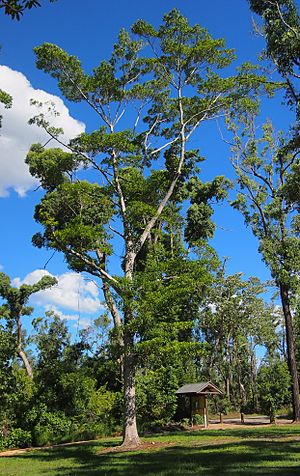Rose walnut facts for kids
Quick facts for kids Rose walnut |
|
|---|---|
 |
|
| Scientific classification | |
| Genus: |
Endiandra
|
| Species: |
discolor
|
The Rose Walnut (scientific name: Endiandra discolor) is a special tree that grows in Australia. You can find it in rainforests from New South Wales all the way up to Queensland. People also call it the Domatia Tree because of a cool feature on its leaves.
This tree is a type of rainforest tree that often has big, strong roots called buttresses. It likes to grow in tropical and warm areas, especially on certain types of soil or near streams.
Contents
What Does the Rose Walnut Look Like?
The Rose Walnut is a medium to large tree. It can grow very tall, sometimes up to 40 metres high! Its trunk can be quite wide, about 90 centimetres across.
Tree Trunk and Bark
The bottom of the tree often has large, wide roots called buttresses. These can be as tall as 2 metres on big trees. They help the tree stay stable.
The bark of the tree is usually brown or brownish-grey. When the tree is young, its bark is smooth. As it gets older, the bark becomes rougher and can have small dips. Sometimes, tiny insects live in these dips! New branches on the tree are covered with soft, fuzzy hairs.
Leaves of the Rose Walnut
The leaves of the Rose Walnut grow one after another along the stem. They do not have jagged edges. Each leaf is about 6 to 10 centimetres long and 2 to 5 centimetres wide. They are usually oval-shaped with a blunt or slightly pointed tip. The leaf stem is short, about 5 to 10 millimetres long.
The top side of the leaf is shiny. The bottom side is a lighter, greyish colour. The name discolor means "two colours," which describes how the top and bottom of the leaf look different.
You can see the veins clearly on both sides of the leaf, especially on the underside. The main vein and side veins are often a pale green. The Rose Walnut is also called the Domatia Tree because of special raised bumps on the underside of its leaves. These bumps look like tiny kidneys. They are found where the main vein meets some of the side veins.
Flowers and Fruit
Tiny, creamy-green flowers appear on the tree in October and November. They are only about 2 millimetres long but smell sweet! These flowers grow in clusters that are shorter than the leaves.
The fruit of the Rose Walnut ripens from March to April. It is a shiny black fruit called a drupe, about 20 to 25 millimetres long. Inside the fruit, there is green flesh around an oval-shaped seed. The seed is about 15 to 20 millimetres long and has slight ridges, like many Australian laurel trees. If you want to plant the seeds, you need to remove the green flesh first.
Who Eats the Rose Walnut?
The fruit of the Rose Walnut is a tasty treat for many rainforest birds. Birds like the wompoo fruit dove, catbird, rose crowned fruit dove, superb fruit-dove, and topknot pigeon all enjoy eating them.
The leaves of the Rose Walnut are also important. They are food for the young caterpillars (larvae) of the beautiful Macleay's swallowtail butterfly. This tree is also a host plant for a type of fruit fly called Bactrocera endiandrae.
- PlantNET - The Plant Information Network System of Botanic Gardens Trust, Sydney, Australia - http://plantnet.rbgsyd.nsw.gov.au/cgi-bin/NSWfl.pl?page=nswfl&lvl=sp&name=Endiandra~discolor
See also
 In Spanish: Endiandra discolor para niños
In Spanish: Endiandra discolor para niños


